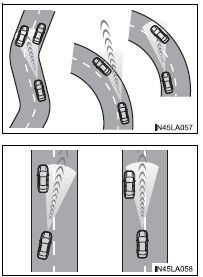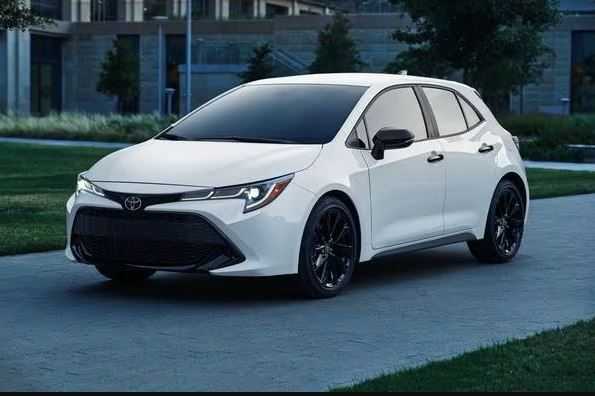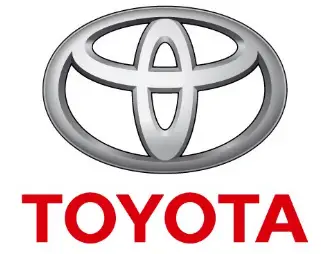2020 Toyota Corolla Dynamic Radar Cruise Control Owner’s Manual
Dynamic Radar Cruise Control (DRCC) improves driver convenience and safety when driving on a highway by automatically adjusting speed to maintain a predetermined distance from the car ahead of the 2020 Toyota Corolla.
2023 – 2024 Toyota Corolla Review, Price, Features And Mileage (Brochure)
Toyota Dynamic Radar Cruise Control Guide
In vehicle-to-vehicle distance control mode, the vehicle automatically accelerates and decelerates to match the speed changes of the preceding vehicle even if the accelerator pedal is not depressed. In constant speed control mode, the vehicle runs at a fixed speed.
Use the dynamic radar cruise control on freeways and highways.
- Vehicle-to-vehicle distance control mode
- Constant speed control mode
System Components
Meter display
- Multi-information display
- Set speed
- Indicators
Operation switches
- Vehicle-to-vehicle distance switch
- “+RES” switch
- Cruise control main switch
- Cancel switch
- “-SET” switch
WARNING
Before using dynamic radar cruise control
- Driving safely is the sole responsibility of the driver. Do not rely solely on the system, and drive safely by always paying careful attention to your sur-roundings.
- The dynamic radar cruise control provides driving assistance to reduce the driver’s burden. However, there are limitations to the assistance provided.
Read the following conditions carefully. Do not overly rely on this system and always drive carefully.- When the sensor may not be correctly detecting the vehicle ahead:
- Conditions under which the vehicle-to-vehicle distance con-trol mode may not function correctly:
- Set the speed appropriately depending on the speed limit, traffic flow, road conditions, weather conditions, etc. The driver is responsible for checking the set speed.
- Even when the system is functioning normally, the condition of the preced-ing vehicle as detected by the system may differ from the condition observed by the driver. Therefore, the driver must always remain alert, assess the danger of each situation and drive safely. Relying on this system or assuming the system ensures safety while driving can lead to an acci-dent, resulting in death or serious injury.
- Switch the dynamic radar cruise control setting to off, using the cruise control main switch when not in use.
Cautions regarding the driving assist systems
Observe the following precautions, as there are limitations to the assistance provided by the system.
Failure to do so may cause an accident resulting in death or serious injury.
- Assisting the driver to measure following distance
The dynamic radar cruise control is only intended to help the driver in determining the following distance between the driver’s own vehicle and a designated vehicle traveling ahead. It is not a mechanism that allows care-less or inattentive driving, and it is not a system that can assist the driver in low-visibility conditions. It is still necessary for driver to pay close attention to the vehicle’s surroundings. - Assisting the driver to judge proper following distance
The dynamic radar cruise control determines whether the following dis-tance between the driver’s own vehicle and a designated vehicle traveling ahead is within a set range. It is not capable of making any other type of judgement. Therefore, it is absolutely necessary for the driver to remain vigilant and to determine whether or not there is a possibility of danger in any given situation. - Assisting the driver to operate the vehicle
The dynamic radar cruise control has limited capability to prevent or avoid a collision with a vehicle traveling ahead. Therefore, if there is ever any danger, the driver must take immediate and direct control of the vehicle and act appropriately in order to ensure the safety of all involved.
Situations unsuitable for dynamic radar cruise control
Do not use dynamic radar cruise control in any of the following situ-ations. Doing so may result in inappropriate speed control and could cause an accident resulting in death or serious injury.
- Roads where there are pedes-trians, cyclists, etc.
- In heavy traffic
- On roads with sharp bends
- On winding roads
- On slippery roads, such as those covered with rain, ice or snow
- On steep downhills, or where there are sudden changes between sharp up and down gradients
Vehicle speed may exceed the set speed when driving down a steep hill. - At entrances to freeways and highways
- When weather conditions are bad enough that they may pre-vent the sensors from detecting correctly (fog, snow, sand-storm, heavy rain, etc.)
- When there is rain, snow, etc. on the front surface of the radar or front camera
- In traffic conditions that require frequent repeated acceleration and deceleration
- During emergency towing
- When an approach warning buzzer is heard often
Driving in vehicle-to-vehicle distance control mode
This mode employs a radar to detect the presence of vehicles up to approximately 328 ft. (100 m) ahead, determines the current vehi-cle-to-vehicle following distance, and operates to maintain a suitable following distance from the vehicle ahead. The desired vehi-
cle-to-vehicle distance can also be set by operating the vehi-
cle-to-vehicle distance switch.
When driving on downhill slopes, the vehicle-to-vehicle distance may become shorter.

- Example of constant speed cruising
When there are no vehicles ahead
The vehicle travels at the speed set by the driver. - Example of deceleration cruising and follow-up cruising
When a preceding vehicle driving slower than the set speed
appears
When a vehicle is detected running ahead of you, the system automatically decelerates your vehicle. When a greater reduction in vehicle speed is nec-essary, the system applies the brakes (the stop lights will come on at this time). The system will respond to changes in the speed of the vehicle ahead in order to maintain the vehicle-to-vehicle distance set by the driver. Approach warning warns you when the system cannot decelerate suffi-ciently to prevent your vehicle from closing in on the vehicle ahead.
When the turn signal lever is operated and your vehicle moves to a left lane while driving at 50 mph (80 km/h) or more, the vehicle will quickly acceler-ate to help to overtake a passing vehicle. - Example of acceleration
When there are no longer any preceding vehicles driving slower
then the set speed
The system accelerates until the set speed is reached. The system then returns to constant speed cruising.
Setting the vehicle speed (vehicle-to-vehicle distance control mode)
- Press the “ON-OFF” button to activate the cruise control.
Dynamic radar cruise control indi-cator will come on and a message will be displayed on the multi-infor-mation display. Press the switch again to deactivate the cruise con-trol.
If the cruise control main switch is pressed and held for 1.5 seconds or more, the system turns on in constant speed control mode.
- Accelerate or decelerate, with accelerator pedal operation, to the desired vehicle speed (at or above approximately 30 mph [50 km/h]) and push the lever down to set the speed.
Cruise control “SET” indicator will come on.
The vehicle speed at the moment the switch is released becomes the set speed.
Adjusting the set speed
To change the set speed, press the “+RES” or “-SET” switch until the desired set speed is displayed.
- Increases the speed
- Decreases the speed
Fine adjustment: Press the switch.
Large adjustment: Press and hold the switch to change the speed, and release when the desired speed is reached.
In the vehicle-to-vehicle dis-tance control mode, the set speed will be increased or decreased as follows:
For the U.S. mainland and Hawaii
Fine adjustment: By 1 mph (1.6
km/h)*1 or 1 km/h (0.6 mph)*2 each time the switch is pressed
Large adjustment: Increases or
decreases in 1 mph (1.6 km/h)*1 or
1 km/h (0.6 mph)*2 increments for as long as the switch is held
Except for the U.S. mainland and Hawaii
Fine adjustment: By 1 mph (1.6
km/h)*1 or 1 km/h (0.6 mph)*2 each time the switch is pressed
Large adjustment: Increases or
decreases in 5 mph (8 km/h)*1 or 5
km/h (3.1 mph)*2 increments for as long as the switch is held
In the constant speed control mode, the set speed will be increased or decreased as follows:
Fine adjustment: By 1 mph (1.6
km/h)*1 or 1 km/h (0.6 mph)*2 each time the switch is pressed
Large adjustment: The speed will continue to change while the switch is held.- When the set speed is shown in “MPH”
- When the set speed is shown in “km/h”
Changing the vehicle-to-vehicle distance (vehicle-to-vehicle distance control mode)
Pressing the switch changes the vehicle-to-vehicle distance as follows:
- Long
- Medium
- Short
The vehicle-to-vehicle distance is set automatically to long mode when the engine switch is turned to ON.
If a vehicle is running ahead of you, the preceding vehicle mark also be displayed.
Vehicle-to-vehicle distance settings (vehicle-to-vehicle distance control mode)
Select a distance from the table below. Note that the distances shown correspond to a vehicle speed of 50 mph (80 km/h). Vehicle-to-vehicle distance increases/decreases by vehicle speed.
| Distance options | Vehicle-to-vehicle distance |
| Long | Approximately 160 ft. (50 m) |
| Medium | Approximately 130 ft. (40 m) |
| Short | Approximately 100 ft. (30 m) |
Canceling and resuming the speed control
- Pressing the cancel switch cancels the speed control.
The speed control is also canceled when the brake pedal is depressed. - Pressing the “+RES” switch resumes the cruise control and returns vehicle speed to the set speed.
However, cruise control does not resume when the vehicle speed is approximately 16 mph (25 km/h) or less.
Approach warning (vehicle-to-vehicle distance control mode)
When your vehicle is too close to a vehicle ahead, and sufficient automatic deceleration via the cruise control is not possible, the display will flash and the buzzer will sound to alert the driver. An example of this would be if another driver cuts in front of you while you are following a vehicle. Depress the brake pedal to ensure an appropriate vehicle-to-vehicle distance.
Warnings may not occur when
In the following instances, warnings may not occur even when the vehicle-to-vehicle distance is small.
- When the speed of the preceding vehicle matches or exceeds your vehicle speed
- When the preceding vehicle is traveling at an extremely slow speed
- Immediately after the cruise control speed was set
- When depressing the accelerator pedal
Selecting constant speed control mode
When constant speed control mode is selected, your vehicle will main-tain a set speed without controlling the vehicle-to-vehicle distance. Select this mode only when vehicle-to-vehicle distance control mode does not function correctly due to a dirty radar sensor, etc.
- With the cruise control off, press and hold the “ON-OFF” button for 1.5 seconds or more.
Immediately after the “ON-OFF” button is pressed, the radar cruise control indicator will come on. Afterwards, it switches to the cruise control indicator.
Switching to constant speed con-trol mode is only possible when operating the lever with the cruise control off.
- Accelerate or decelerate, with accelerator pedal operation, to the desired vehicle speed (at or above approximately 25 mph [40 km/h]) and push the lever down to set the speed.
Cruise control “SET” indicator will come on.
The vehicle speed at the moment the lever is released becomes the set speed.
Adjusting the speed setting: Canceling and resuming the speed setting:
Dynamic radar cruise control can be set when
- Vehicles with a continuously vari-able transmission: The shift lever is in D.
- Vehicles with a manual transmis-sion: The shift lever is in range 2nd or higher.
- Depending on the control mode, this item can be set at the follow-ing speeds.
- Vehicle-to-vehicle distance con-trol mode: Approximately 20 mph (30 km/h) or more
- Constant speed control mode: Approximately 20 mph (30 km/h) or more
Accelerating after setting the vehicle speed
The vehicle can accelerate by operating the accelerator pedal. After acceler-ating, the set speed resumes. However, during vehicle-to-vehicle distance control mode, the vehicle speed may decrease below the set speed in order to maintain the distance to the preceding vehicle.
Shift position selection (vehi-cles with a manual transmis-sion)
Select a shift position according to the vehicle speed. If the engine speed is too high or too low, control may be automatically canceled.
2023 – 2024 Toyota Corolla Review, Price, Features And Mileage (Brochure)
Automatic cancelation of vehicle-to-vehicle distance control mode
Vehicle-to-vehicle distance control mode is automatically canceled in the fol-lowing situations:
- Actual vehicle speed falls at or below approximately 25 mph (40 km/h).
- VSC is activated.
- TRAC is activated for a period of time.
- When the VSC or TRAC system is turned off.
- The sensor cannot detect correctly because it is covered in some way.
- Pre-collision braking is activated.
- Vehicles with a manual transmis-sion: When the shift lever is in N or the clutch pedal is depressed for a certain amount of time or more.
If vehicle-to-vehicle distance control mode is automatically canceled for any reasons other than the above, there may be a malfunction in the system. Contact your Toyota dealer.
Automatic cancelation of constant speed control mode
Constant speed control mode is automatically canceled in the following situa-tions:
- Actual vehicle speed is more than approximately 10 mph (16 km/h) below the set vehicle speed.
- Actual vehicle speed falls below approximately 25 mph (40 km/h).
- VSC is activated.
- TRAC is activated for a period of time.
- When the VSC or TRAC system is turned off.
- Pre-collision braking is activated.
- Vehicles with a manual transmis-sion: When the shift lever is in N or the clutch pedal is depressed for a certain amount of time or more.
If constant speed control mode is automatically canceled for any rea-sons other than the above, there may be a malfunction in the system. Contact your Toyota dealer.
Brake operation
A brake operation sound may be heard and the brake pedal response may change, but these are not mal-functions.
Warning messages and buzzers for dynamic radar cruise control Warning messages and buzzers are used to indicate a system malfunction or to inform the driver of the need for caution while driving. If a warning message is shown on the multi-information display, read the message and follow the instructions.
When the sensor may not be correctly detecting the vehicle ahead
In the case of the following and depending on the conditions, operate the brake pedal when deceleration of the system is insufficient or operate the accelerator pedal when acceleration is required.
As the sensor may not be able to correctly detect these types of vehicles, the approach warning may not be activated.
- Vehicles that cut in suddenly
- Vehicles traveling at low speeds
- Vehicles that are not moving in the same lane
- Vehicles with small rear ends (trailers with no load on board, etc.)

- Motorcycles traveling in the same lane
- When water or snow thrown up by the surrounding vehicles hinders the detecting of the sensor
 When your vehicle is pointing upwards (caused by a heavy load in the luggage compartment, etc.)
When your vehicle is pointing upwards (caused by a heavy load in the luggage compartment, etc.)- Preceding vehicle has an extremely high ground clearance
Conditions under which the vehicle-to-vehicle distance control mode may not function correctly
In the case of the following conditions, operate the brake pedal (or accelera-tor pedal, depending on the situation) as necessary.
As the sensor may not be able to correctly detect vehicles ahead, the system may not operate properly.
 When the road curves or when the lanes are narrow
When the road curves or when the lanes are narrow- When steering wheel operation or your position in the lane is unstable
- When the vehicle ahead of you decelerates suddenly
- When driving on a road surrounded by a structure, such as in a tunnel or on a bridge
- While the vehicle speed is decreasing to the set speed after the vehicle accelerates by depressing the accelerator pedal
FAQs
Dynamic Radar Cruise Control (DRCC) is an advanced system in the 2020 Toyota Corolla that maintains a set speed and distance from the vehicle ahead using radar and camera technology.
The DRCC system in the 2020 Toyota Corolla uses a front-grille-mounted radar and a forward-facing camera to detect vehicles and their distance, adjusting the speed to maintain a preset distance.
The DRCC in the 2020 Toyota Corolla can bring the car to a complete stop if the vehicle ahead stops, and it can resume speed when it starts moving again.
To activate DRCC in the 2020 Toyota Corolla, press the “ON” button on the cruise control lever, set the desired speed using the lever, and adjust the following distance using the steering wheel-mounted controls.
The DRCC in the 2020 Toyota Corolla operates at speeds ranging from 0 to approximately 110 mph, depending on the driving conditions and the speed of the vehicle ahead.
The DRCC system in the 2020 Toyota Corolla may not function optimally in adverse weather conditions such as heavy rain, snow, or fog, as these can obstruct the radar and camera sensors.
Useful Links
View Full PDF: Toyota Corolla 2020 User Manual |Auto User Guide


